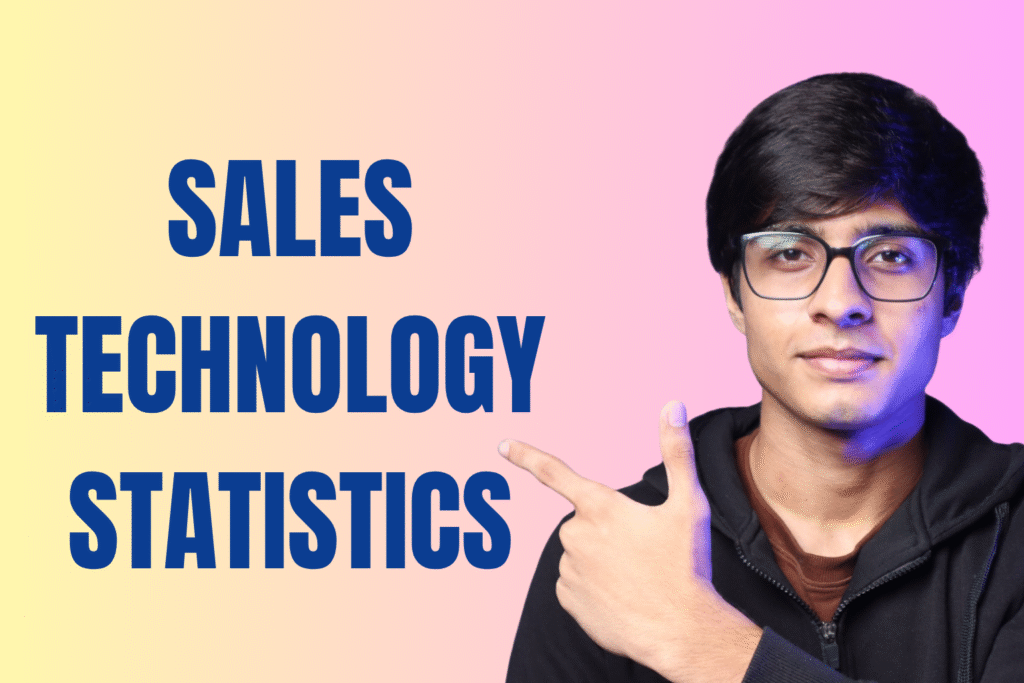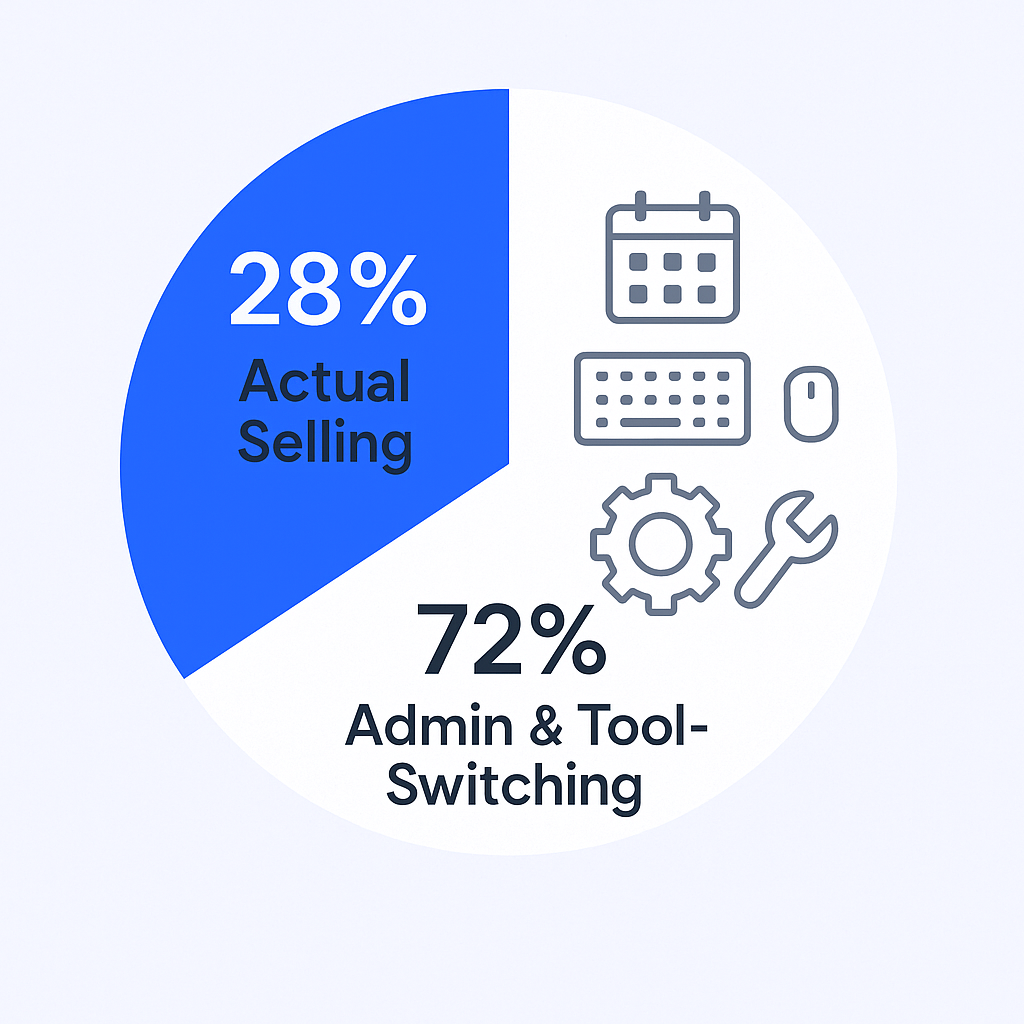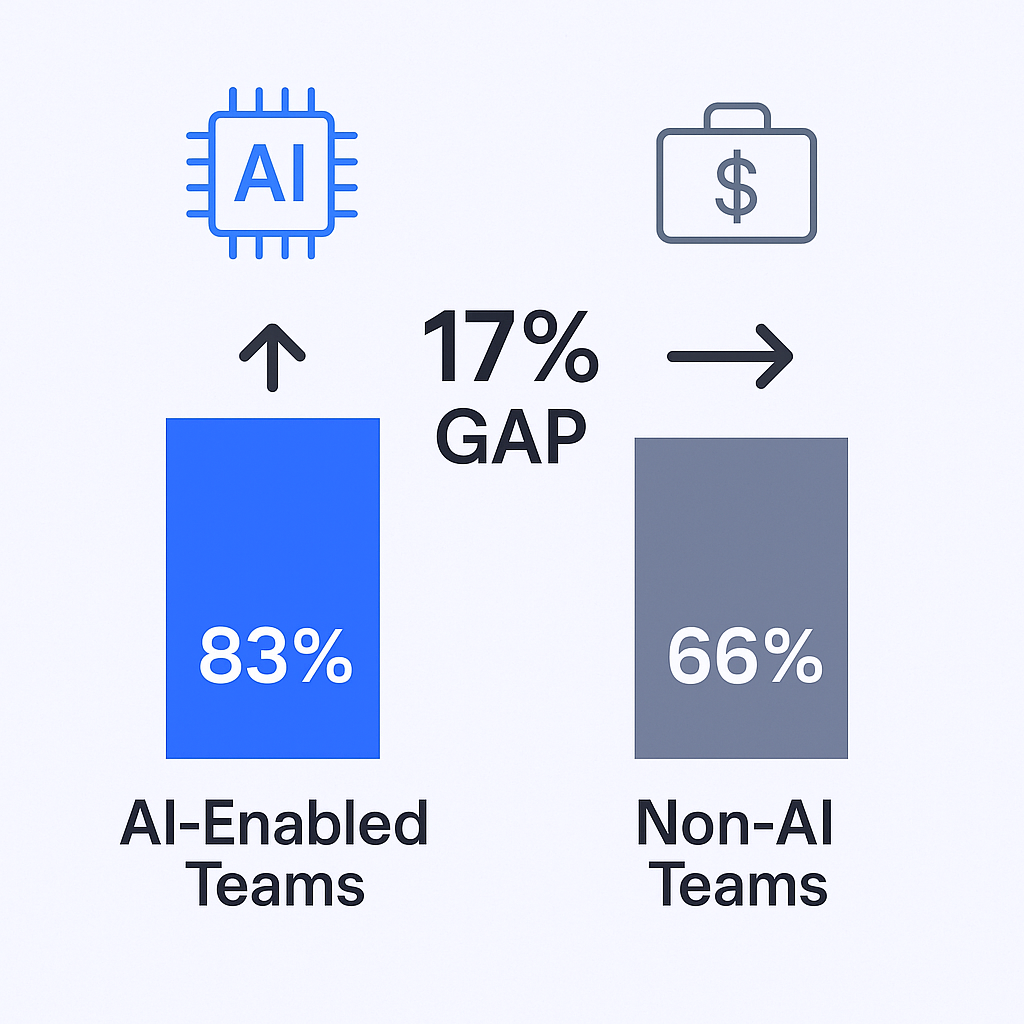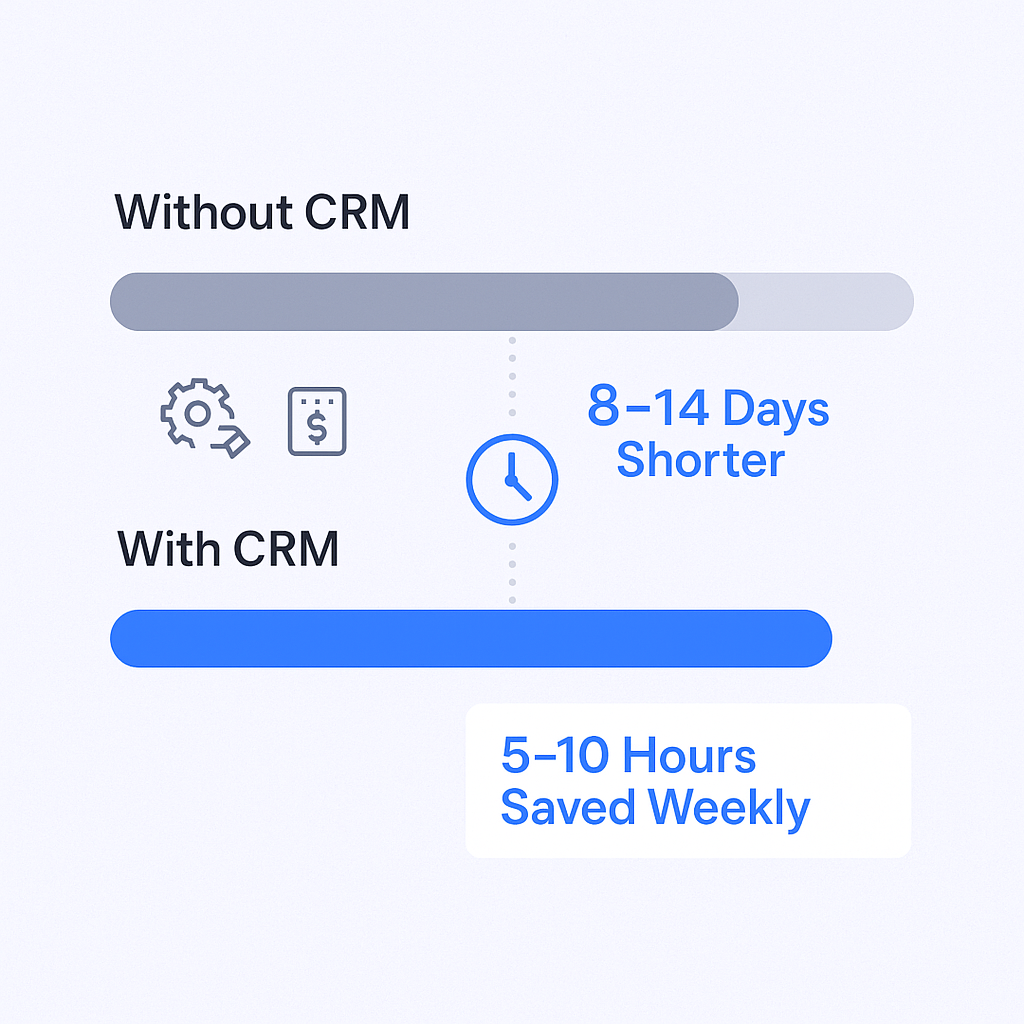- blog
- Statistics
- Sales Technology Statistics 2025: AI & CRM Data

Table of Contents
Sales Technology Statistics
- Sales reps spend only 28% of their week actually selling, with the rest lost to admin work and tool-switching
- 83% of sales teams using AI saw revenue growth, compared to just 66% of teams without it
- Sales teams currently use an average of 10 different tools to close deals, creating massive complexity
- 66% of sales reps feel completely overwhelmed by technology instead of empowered by it
- 94% of sales organizations are planning to consolidate their tech stacks within the next year
- 49% of technology leaders say AI is fully integrated into their core business strategy, not just testing
- 71% of organizations now regularly use Generative AI in at least one business function across the company
- Gen AI market for marketing and sales is projected to hit $22 billion by 2032, showing explosive growth
- 73% of businesses use CRM software in 2025, making it foundational infrastructure for sales teams
- Companies using CRM are 86% more likely to exceed their sales goals than those without one
- CRMs help employees save 5-10 hours per week by automating repetitive tasks and streamlining workflows
- 65% of businesses have adopted CRM systems with Generative AI capabilities, integrating predictive intelligence with data
- 87% of CRM usage is cloud-based, providing accessibility that modern hybrid sales teams demand
- Mobile access through cloud solutions boosts sales productivity by 14.6%, enabling work from anywhere
- Strategic implementation of AI and automation could boost annual sales productivity by up to $1.2 trillion globally
Here’s something wild: your sales reps spend only 28% of their week actually selling. The rest? Lost to admin work, tool-switching, and data entry.
But here’s the good news buried in the chaos—83% of sales teams using AI saw revenue growth, compared to just 66% of teams without it. The gap is massive, and it’s getting wider.
The problem isn’t technology itself. It’s that most teams are drowning in it. The average team juggles 10+ different tools just to close deals, and 66% of reps feel completely overwhelmed by the sheer volume of software they’re supposed to master.
So what actually works? Let’s cut through the noise with data-based insights that’ll help you make smarter decisions about your sales tech stack.

The Evolving Landscape of Sales Technology
What Is Sales Technology?
Sales technology refers to tools and applications designed to support sales professionals and boost their effectiveness. These aren’t just nice-to-have features anymore—they’re the foundation of how modern revenue teams operate.
But here’s where it gets messy. Sales teams currently use an average of 10 different tools to close deals, and the result is predictable: 66% of sales reps feel overwhelmed by technology instead of empowered by it. Context-switching between platforms kills momentum, fragments data, and burns time that should be spent with prospects.
The wake-up call? 94% of sales organizations are planning to consolidate their tech stacks within the next year. This isn’t about cutting costs—it’s about survival. Teams finally realize that scattered tools create scattered results.
Why Staying Updated Matters
The sales game has fundamentally shifted. What used to be transactional has become deeply consultative. Every customer interaction now requires advanced data intelligence, and falling behind on technology trends means losing competitive edge—fast.
Consider this: 49% of technology leaders say AI is “fully integrated” into their core business strategy. Not “testing it out” or “exploring options”—fully integrated. AI has moved from experimental to essential in less than three years.
The stakes are clear. Teams that adapt to emerging sales technology statistics outperform those that don’t, and the performance gap widens every quarter.
AI-Powered Contact Centers and Intelligence
Let’s talk about the elephant in the room: artificial intelligence. AI is transforming sales from educated guessing into precision work.
The performance data speaks volumes. 83% of sales teams using AI saw revenue growth, while only 66% of non-AI teams hit the same mark. That’s not a slight edge—that’s a 17-point gap that translates directly to your bottom line.

Adoption is exploding. 71% of organizations now regularly use Generative AI in at least one business function, and the market is responding accordingly. The Gen AI market for marketing and sales is projected to hit $22 billion by 2032.
Here’s where it gets interesting for your team’s structure. 35% of Chief Revenue Officers will establish centralized AI teams by 2025 to ensure AI is embedded into core strategy rather than bolted on as an afterthought.
Looking ahead, the automation gets even more aggressive. By 2029, Agentic AI is expected to autonomously resolve 80% of common customer service issues, which should yield a 30% reduction in operational costs. This means your human reps can focus entirely on complex, high-value deals instead of routine inquiries.
The trust issue remains real, though. Only 42% of customers trust businesses using AI ethically, which means transparency and governance aren’t optional—they’re competitive differentiators.
🎯 LinkedIn Outbound Done Right
Skip the tech overwhelm. Our complete LinkedIn strategy delivers qualified leads without tool-switching chao
CRM Systems: The Foundation
If AI is the brain of your sales operation, your CRM is the nervous system connecting everything.
73% of businesses use CRM software in 2025, and the performance impact is undeniable. Companies using CRM are 86% more likely to exceed their sales goals than those flying blind without one.
The time savings alone justify the investment. CRMs help employees save 5-10 hours per week by automating repetitive tasks, and they shorten the average sales cycle by 8-14 days. In cold outreach specifically, where every day counts, that cycle reduction can transform your quarterly numbers.

The CRM market continues its explosive growth, projected to reach $129 billion by 2028 at 12% annual growth. But the real magic happens when you combine CRM with AI. 65% of businesses have adopted CRM systems with Generative AI capabilities, and these integrated systems show remarkable results.
Organizations leveraging Gen AI in their CRM are 83% more likely to exceed sales goals. The combination of centralized data and predictive intelligence creates a compound effect that neither technology can achieve alone.
For teams doing cold email outreach, this integration becomes critical. Your CRM becomes the single source of truth that informs AI-powered personalization, helping sales professionals accelerate sales cycles through smarter targeting and messaging.
📈 Consolidate Your Prospecting Stack
LinkedIn outbound targeting, campaign design, and scaling—all managed by experts who drive measurable pipeline growth.
Cloud-Based Solutions
Cloud deployment in sales technology is now virtually universal, and for good reason.
87% of CRM usage is cloud-based, providing the accessibility that modern sales teams demand. Consider that 81% of CRM users access their software from multiple devices—this isn’t about preference, it’s about necessity in a hybrid work world.
The productivity impact is measurable. Mobile access through cloud solutions boosts sales productivity by 14.6%, giving reps the flexibility to update records, check pipeline status, and respond to prospects from anywhere.
The market validates this shift. The global cloud CRM market is projected to reach $175.82 billion by 2031, reflecting how essential cloud infrastructure has become to sales operations.
For sales teams doing prospecting and outreach, cloud solutions provide the instant scalability needed to handle growth or seasonal fluctuations without infrastructure headaches. When you need to ramp up email sending capabilities or expand your outbound efforts, cloud platforms flex with you.
Advanced Data Tools
Sales Intelligence and Predictive Analytics
Sales intelligence tools collect and analyze data from multiple sources to provide actionable insights. They help sales teams identify ideal leads, personalize outreach, improve qualification, and close deals faster through advanced analytics.
The economic potential is staggering. Strategic implementation of AI and automation could boost annual sales productivity by up to $1.2 trillion globally through increased speed and efficiency gains.
These tools fundamentally change what’s required from sales professionals. The job shifts from finding leads to interpreting predictive signals and acting on high-probability opportunities—a more technical, analytical skill set than traditional sales demanded.
Automation in Sales Processes
Sales automation tackles the productivity crisis head-on. Right now, administrative tasks consume roughly 72% of a rep’s time. Automation streamlines the error-prone manual work—prospecting, calendaring, data entry, lead scoring—freeing reps to focus on actual selling.
For smaller organizations, automation enables the full-cycle sales model where a single rep can handle the entire process from prospecting through closing. This shift makes sense when you consider that automation handles the repetitive early-stage work while humans focus on relationship building and closing.
When combined with clean data and unified systems, automation becomes the force multiplier that lets lean sales teams punch above their weight.
Chatbots and Conversational AI
Conversational AI has moved from novelty to customer expectation. 73% of consumers now expect websites to offer chatbots for easy communication, and the market is responding aggressively.
The AI agents market is projected to surge from $5.1 billion in 2024 to $47.1 billion by 2030—that’s a 44.8% compound annual growth rate.
The preference data reveals why this growth is happening. 34% of consumers prefer working with AI agents rather than humans specifically to avoid repeating themselves during interactions. AI’s superior ability to synthesize information and maintain context makes it ideal for initial screening and data collection.
This means the first human interaction in your sales process can be high-value and complex, because AI has already handled qualification and information gathering.
Immersive Technologies
IoT Integration for Personalization
Internet of Things technology provides the real-time data streams that enable true personalization at scale.
The business case is compelling. 80% of business leaders report that consumers spend more when their experience is highly personalized. Better yet, 49% of customers become repeat buyers after receiving a personalized shopping experience.
IoT devices collect granular data—in-store interactions, usage patterns, behavioral signals—that refine predictive models and improve forecasting accuracy. For B2B sales teams, this translates to understanding exactly when prospects are ready to buy and what specific pain points need addressing.
AR and VR for Product Demonstrations
Augmented and Virtual Reality are eliminating pre-purchase doubt through immersive experiences.
The conversion data is remarkable. Products advertised with AR/VR content see a 94% higher conversion rate than products without it. That’s not incremental improvement—that’s transformation.
AR experiences are 200% more engaging than standard digital content, and 61% of consumers prefer retailers that offer AR experiences. The value perception shift matters too: 40% of shoppers are willing to pay more for a product if they can virtually test it using AR.
In B2B specifically, immersive tech use for SaaS product demonstrations increased by 70% during the shift to remote sales, proving its utility for complex selling environments. When you can’t meet face-to-face, immersive technology bridges the trust gap that video calls can’t fully close.
Social Selling Platforms
Social selling has evolved from a supplementary tactic to a core revenue driver.
Organizations using social selling strategies see a 61% increase in revenue growth. The individual rep impact is equally dramatic: sales professionals who actively practice social selling are 66% more likely to achieve their quotas compared to peers using only traditional techniques.
LinkedIn dominates the B2B space. 89% of B2B marketers use it for lead generation, finding it 277% more effective than Facebook or X (formerly Twitter). The platform’s professional context makes it ideal for building credibility and reaching decision-makers.
The executive influence is undeniable. 84% of CEOs and VPs use social media to inform their purchasing decisions, and 92% of B2B buyers prefer engaging with sales professionals who are recognized as thought leaders online.
For teams building outbound prospecting strategies, social selling provides the warm-up that makes cold outreach warmer. Your digital presence builds credibility before the first email even lands.
💼 LinkedIn Lead Generation Experts
Stop guessing at social selling. Get proven LinkedIn campaigns with targeting precision and scalable execution strategies
Sales Enablement Platforms
Sales enablement platforms solve the training and resource delivery problem that tech stack complexity creates.
The market is growing at 16.3% CAGR, projected to reach $12.78 billion by 2030. This growth reflects how critical enablement has become as tools multiply and complexity increases.
The performance impact is direct. Companies using sales enablement tools are 19% more likely to see an increase in their average win rate year over year.
These platforms deliver content, training, and playbooks directly within the tools reps already use. As 94% of organizations plan to consolidate their tech stacks, enablement platforms become the connective tissue that ensures consolidated systems actually drive performance instead of just reducing license costs.
Think of enablement as the bridge between technology investment and human capability. Without it, even the best tools sit unused because reps don’t know how to leverage them effectively.
Sales Closing Statistics: The Bottom Line
Despite all the technological advancement, closing remains the critical bottleneck. 35% of salespeople cite closing as the hardest part of the entire sales process, ranking second only to prospecting.
Understanding industry benchmarks helps you assess whether your tech stack is actually working:
The general average close rate across all industries stands at 20%. Inside sales representatives, who rely heavily on digital tools and high-volume interactions, average 18%. In contrast, outside sales representatives who engage in high-touch, face-to-face consultative deals achieve an average of 40%.
Industry-specific benchmarks reveal the performance spectrum:
- Outside sales average: 40% (high-touch, consultative transactions)
- Business/industrial: 27% (often uses specialized technical sales support)
- Electronics/IT hardware: 23% (high reliance on product knowledge)
- Computer software/tech: 22% (outperforms inside sales through efficiency tech)
- Inside sales average: 18% (highest volume, lowest close rate)
Here’s what matters: the computer software industry—intrinsically dependent on sales technology—achieves a 22% close rate, outperforming the general 18% inside sales benchmark. This proves that effective, consolidated sales technology allows high-volume teams to punch above their weight class.
The 22-point gap between the 18% inside sales rate and the 40% outside sales rate represents the ultimate opportunity. The next generation of breakthrough sales technology will combine AR/VR immersion (94% conversion boost) with predictive AI to lift digital selling efficiency closer to that high-touch 40% benchmark.
Choosing the Right Sales Technology
With 94% of sales organizations planning to consolidate their tech stacks, the strategic question isn’t whether to streamline—it’s how to do it intelligently.
Your consolidation strategy should prioritize three outcomes: enhanced collaboration, unified data sources for 360-degree customer views, and streamlined processes that return selling time to your reps.
Calculate the true value of consolidation by examining its impact on quota attainment and operational efficiency—not just licensing cost savings. When 66% of sales reps are drowning in tools, the human cost of complexity often exceeds the software cost.
Your technology must be simple for reps to use, sophisticated for data processing, and transparent for customer trust. Miss any of these three, and adoption fails.
For teams focused on outbound prospecting and cold outreach, this means choosing solutions that integrate email address verification, sending infrastructure, and CRM updates into a single workflow. When tools like Salesso consolidate verified contact data with email delivery in one platform, they eliminate the context-switching that kills productivity.
The continued growth of sales enablement platforms validates that maximizing technological ROI requires investing in human capability to use tools effectively. Technology alone doesn’t drive results—enabled sales teams do.
⚡ Simplify Your Sales Outreach
LinkedIn outbound campaigns that eliminate complexity while delivering qualified leads through expert targeting and campaign management.
7-day Free Trial |No Credit Card Needed.
Conclusion
The data reveals a clear dual imperative for 2025 and beyond.
First, consolidate your tech stack to create clean, unified data environments. With 94% of organizations planning consolidation, this isn’t optional—it’s the foundation that enables everything else.
Second, build AI governance and ethical protocols now. With only 42% of customers trusting businesses using AI ethically, transparency becomes your competitive advantage, not just a compliance checkbox.
Your ideal state looks like this: technology that’s simple for reps, sophisticated for data, and transparent for customers. Close deals faster by eliminating tool friction, reclaim the 72% of time lost to admin work, and leverage AI to make every interaction count.
The 83% revenue growth rate for AI-enabled teams versus 66% for traditional teams tells you everything about where this is heading. Technology is no longer optional for competitive growth—but complexity is the enemy of adoption.
Start with consolidation. Build on unified data. Layer in AI strategically. Enable your people continuously. That’s how you turn sales technology statistics into sales technology results.
The gap between winners and losers in sales is widening, and that gap is measured in how intelligently you deploy and consolidate your technology. Choose wisely.
Ready to streamline your outbound prospecting? Salesso provides verified email addresses with built-in deliverability infrastructure, helping sales professionals close deals faster by eliminating data fragmentation and tool-switching. Start consolidating your sales stack today.

Transform Your Sales Tech Stack
Get LinkedIn outbound strategies that consolidate your efforts and drive 3x better ROI
Segmentation That Actually Converts
LinkedIn outbound targets precise demographics with strategic campaign design and scaling methods

